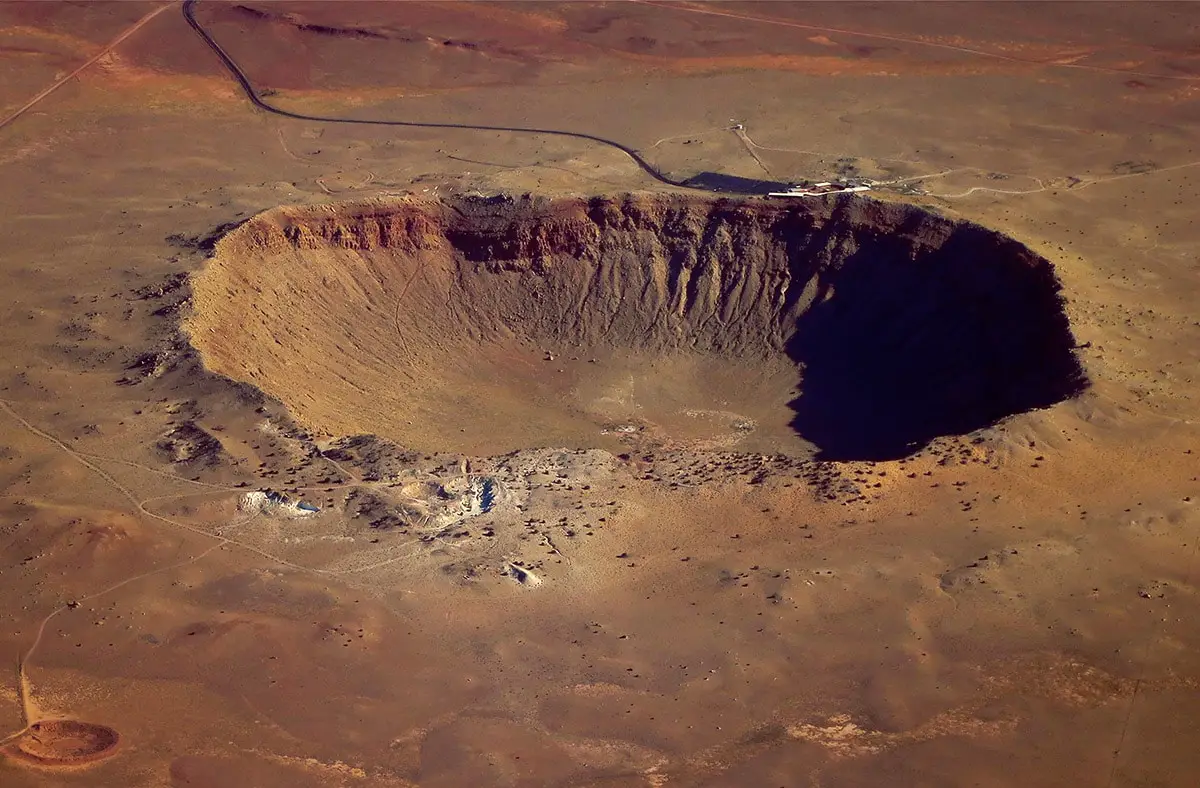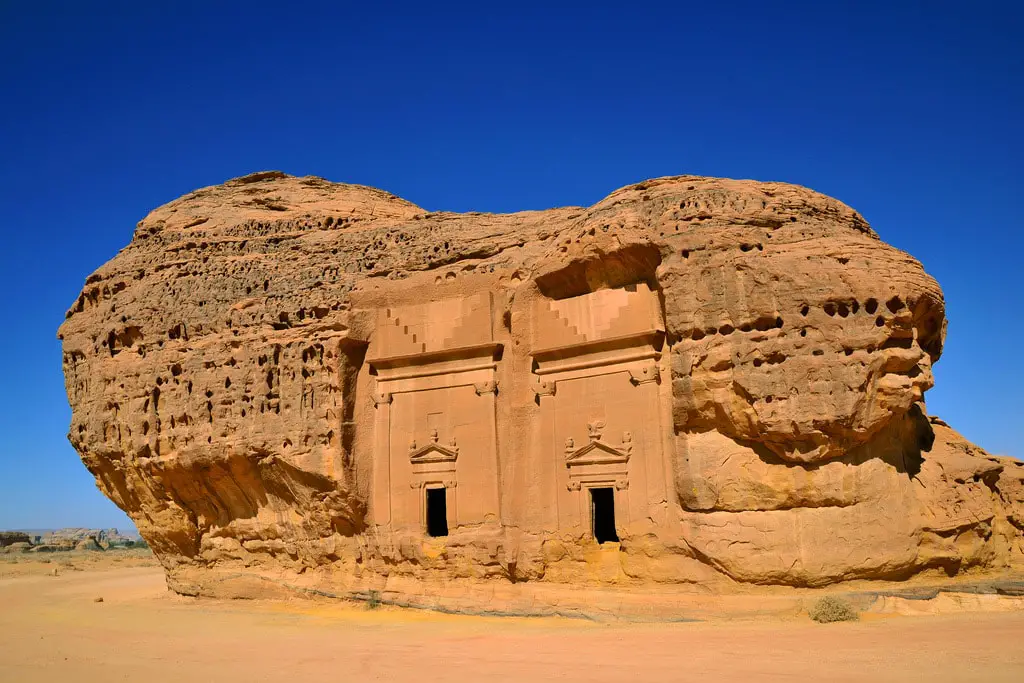World 🢖 Asia 🢖 Saudi Arabia
Impact craters 🢔 Geological wonders 🢔 Categories of wonders
Wonder
Wabar craters (al-Hadida meteors)
 In short
In short
Even the most desolate place on Earth – "Empty Quarter" of Arabia – has its secrets and wonders. This desert was bombarded with a meteorite and as a result Wabar craters were created. It is possible that this happened in the 16th – 18th century.
 20.4%
20.4%
GPS coordinates
Location, address
Name in Arabian
Alternate names
Diameter
Depth
Age
Map of the site
If you see this after your page is loaded completely, leafletJS files are missing.
 In detail
In detail
Legend about the lost city of Ubar
Explorer of Arabia, adventurer and spy John Philby heard the exciting legend in 1918:
Far, in the endless sands of "Empty Quarter" (Rub’ al Khali) are found ruins of the ancient city of Ubar (Wabar).
This was a large, old and beautiful city, which, unfortunately, was ruled by a wicked, lustful ruler. God punished Ubar and sent a destructive wind which eliminated all people in the city and turned it into ruins.
Bedouins told that large chunks of iron can be found in the ruins – as large as camel’s hump. Due to this, they named the site – al-Hadida – "place of iron".
Search of Ubar
Fourteen years passed until Philby had the opportunity to search for ruins of legendary Ubar. He expected to find something comparable to Petra.
Together with a group of very experienced Bedouins he entered the endless sea of sand. "Empty Quarter" is extreme place. For example, in summer it never gets colder than 40° C, and one can not even sleep in the night longer than one hour without drinking some water.
For one month they crisscrossed the sands in this scorching heat until they reached the site on the 2nd February 1932.
What a disappointment! This place was nothing like Petra…
Craters and iron
Explorers saw two shallow craters. The desert in this place was full of chunks of white sandstone, pellets of black glass, and also pieces of iron.
Rims of craters to some extent resembled ruins – but otherwise, there were no signs of human activity. They did not find large chunks of iron either.
While Bedouins were confident that these are ruins of a city destroyed by arcane powers, Philby considered that this landscape was created by volcanoes.
He collected samples and later these samples were investigated by mineralogist Leonard James Spencer in British Museum. Results of the research were convincing – craters were created by meteorite impact.
Three craters
Desert here was hit by more than 3,500 tons of iron from space. Meteorite came at an oblique angle from the northwest, with a speed of some 5 – 7 km per second. Due to shallow angle meteorites experienced high resistance, melted, and divided into several pieces.
Each of the large pieces of meteorite caused an explosion. The largest explosion was comparable to the blast of the atomic bomb in Hiroshima.
Explosion melted the sand, creating a hard sandstone layer on the bottom of craters. This layer contains pellets of sand and coesite – a variety of quartz, which is created by extreme explosions. Rain of melted metal and sand fell on the sand around craters, leaving blackened sand and dark pellets, which by 90% consist of sand and by 10% – of metallic meteorite mass.
Largest meteorites fell in 1,000 by 500 m large area, forming several craters. Mapping in the 1960s registered three craters – 116, 64, and 11 m wide. It is possible that there were several more craters, covered with sand now.
"Camel’s hump"
Stories about the iron meteorite as large as camel’s hump were true. In 1966 Bedouins told that sand in craters shifted and an enormous meteorite is visible.
Journalist of "National Geographic Magazine" Thomas J. Abercrombie managed to visit the place and he really found enormous meteorite – 2,045 kg heavy, approximately 1.2 m wide iron "bullet". This meteorite is a medium octahedrite.
Now "Camel’s hump" is located in Ar Riyadh, King Saud University, in front of Faculty of Science.
Hidden by sand again
When Philby saw the craters, the larger crater was 12.5 m deep. It was gradually filled by sand and in 1965 it was just 8 m deep, but in 1994 – only some 2 m deep.
Two thirds of the rims of the largest crater were covered with sand in 1982.
In the 21st century all traces of these craters most likely would be covered with sand.
Very recent impact
This fast advancement of sand means that these craters are very recent. Thermoluminescence data suggests that their age does not exceed 260 years. But craters could be much younger.
Somewhere in 1863 or 1891 large fireball was observed over Riyadh. Soon samples of iron meteorite – so-called "Nejed" meteorites were obtained from an area which is located just some kilometers from Wabar craters. The chemical content of these meteorites is very similar to the content of Wabar meteorite.
Further research shows that impact happened earlier. On September 1, 1704, people in Tarim, Yemen observed a large fireball falling in this area. Such age concords to the filling rate of craters and thermoluminescence analysis.
What regards the real city of Ubar… It was rediscovered in 1992 further south, in Oman, Dhofar Governorate.
References
- Jeffrey C. Wynn, Eugene M.Shoemaker. The Day the Sands Caught Fire. Scientific American, November 1998. (excellent read!)
 Linked articles
Linked articles

Impact craters
There are many pieces of solid matter flying around in space. And VERY frequently they fall on the surface of the Earth. There are estimates that every year on Earth fall 18,000 – 84,000 meteorites larger than 10 grams: e.g. one meteorite every 6 – 30 minutes.
This category includes outstanding impact craters – detectable scars on the surface of Earth left by a body coming from outer space. The category includes also meteorites – natural objects from outer space.

Wonders of Saudi Arabia
Many landmarks in Saudi Arabia are little known to the outside world, and, unfortunately, many amazing attractions are deliberately destroyed.
Nevertheless some Saudi Arabian landmarks are world-renowned and one – Kaaba in Masjid al-Haram, Makkah – is one of the most important places in the world.

Wonders of Asia
Any other continent (and part of the world) seems small if compared to Asia. This refers also to natural and man-made heritage: in Asia are not just thousands of great landmarks, there are found landmarks created by thousands of diverse cultures from ancient Phoenicians to the mysterious small people in the Philippines and eastern islands of Indonesia.
 Recommended books
Recommended books
Arabian Sands
Arabian Sands is Wilfred Thesiger’s record of his extraordinary journey through the parched “Empty Quarter” of Arabia. Educated at Eton and Oxford, Thesiger was repulsed by the softness and rigidity of Western life—”the machines, the calling cards, the meticulously aligned streets.” In the spirit of T. E. Lawrence, he set out to explore the deserts of Arabia, traveling among peoples who had never seen a European and considered it their duty to kill Christian infidels.

